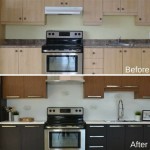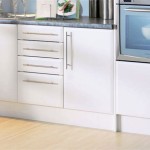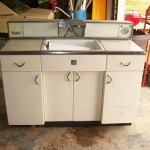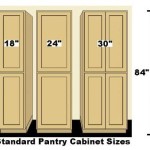Can You Strip Paint From Kitchen Cabinets?
Stripping paint from kitchen cabinets is a viable option when you want to rejuvenate their appearance without replacing them entirely. It allows you to remove old, chipped, or outdated paint to reveal the original wood underneath or prepare the cabinets for a new paint job. While the process can be time-consuming and labor-intensive, it can be a rewarding experience for those who are comfortable with DIY projects.
1. Assessing the Situation: When Stripping Paint Is Ideal
Stripping paint from kitchen cabinets is not always the most efficient solution. Consider the following factors before embarking on this project:
- Number of Layers: If the cabinet doors have multiple layers of paint, stripping can become challenging and time-consuming. Each layer requires removal, which can be a tedious process.
- Paint Type: Certain types of paint, like oil-based paints, can be more difficult to strip than others. Latex-based paints, for instance, tend to be easier to remove.
- Wood Condition: If the wood underneath the paint is damaged or weakened, stripping may not be the ideal solution. In such cases, refinishing or replacing the cabinets might be more appropriate.
- Cabinet Construction: Cabinets with intricate details or delicate surfaces may be more challenging to strip without damaging them.
If you're unsure about the feasibility of stripping paint from your cabinets, it's advisable to consult a professional painter or cabinet refinisher for guidance.
2. Stripping Paint From Kitchen Cabinets: A Step-by-Step Guide
If you decide to proceed with stripping paint from your kitchen cabinets, here's a step-by-step guide to help you through the process:
Preparation
- Remove Cabinet Doors and Hardware: Remove all cabinet doors and hardware, including hinges, knobs, and pulls. This will allow you to strip the paint more effectively and ensure proper access to all surfaces.
- Prepare Workspace: Choose a well-ventilated area, such as a garage or outdoor space. Cover surfaces with drop cloths or plastic sheeting to protect them from paint stripper spills and drips.
- Protect Yourself: Wear appropriate safety gear including gloves, eye protection, and a respirator mask to prevent contact with the paint stripper and its fumes.
Stripping the Paint
- Apply Stripper: Choose a paint stripper suitable for the type of paint on your cabinets. Apply the stripper generously to the surface, following the manufacturer's instructions. Use a paintbrush or scraper to spread the stripper evenly.
- Allow Stripper to Dwell: The stripper needs time to penetrate the paint and soften it. Allow it to sit for the recommended time, which can vary depending on the type of stripper and the paint thickness.
- Scrape Off Paint: Once the paint has softened, use a scraper or putty knife to remove it. Start with gentle scraping, gradually increasing pressure as the paint loosens. Work in sections, and discard the scraped-off paint properly.
- Repeat as Needed: You may need to apply the stripper and scrape multiple times, especially if there are multiple layers of paint. Be patient and work slowly to avoid damaging the wood beneath.
- Neutralize the Stripper: After removing the paint, neutralize the stripper according to the manufacturer's instructions. This step is crucial to prevent further damage to the wood and to ensure safety.
Cleaning and Finishing
- Wash the Cabinets Throroughly: Use soap and water to wash the cabinets to remove any residue from the stripper. Ensure the surface is completely clean and dry before proceeding.
- Sand the Cabinets: Use sandpaper to smooth out any rough edges or imperfections. This will prepare the surface for painting or staining.
- Reinstall Hardware: Once the cabinets are thoroughly cleaned and sanded, reinstall the hardware and doors. Ensure that all hinges, knobs, and pulls are properly secured.
3. Considerations and Alternatives
While stripping paint from kitchen cabinets can be an effective way to restore their appearance, it's important to consider the following:
- Time and Effort: Stripping paint can be a labor-intensive process, requiring several hours or even days to complete. If you're not comfortable with DIY projects or have limited time, it's best to seek professional help.
- Safety: Paint strippers contain chemicals that can be harmful if not used properly. Always wear appropriate safety gear and work in a well-ventilated area.
- Alternatives: If stripping paint is not feasible, consider alternative methods like sanding, priming, and painting directly over the existing paint. In some cases, you might be able to simply apply a layer of primer and paint over the old finish.
Ultimately, the decision of whether to strip paint from kitchen cabinets depends on your personal preferences, time constraints, and the condition of the cabinets. By weighing these factors carefully, you can make an informed decision about the best course of action.

How To Strip Paint Off Kitchen Cabinets And Furniture

An Easier Way To Remove Paint From Wood

How To Strip Paint Off Kitchen Cabinets And Furniture

An Easier Way To Remove Paint From Wood

How To Strip Paint Off Kitchen Cabinets And Furniture

How To Strip And Re Stain Kitchen Cabinets Clinton Township Mi Eason Painting

How To Strip Paint Off Kitchen Cabinets And Furniture

How To Strip Paint Off Furniture And Kitchen Cabinets

How To Strip Paint Off Kitchen Cabinets And Furniture

Preparing Kitchen Cabinets For Painting Stripping And Sc
Related Posts








